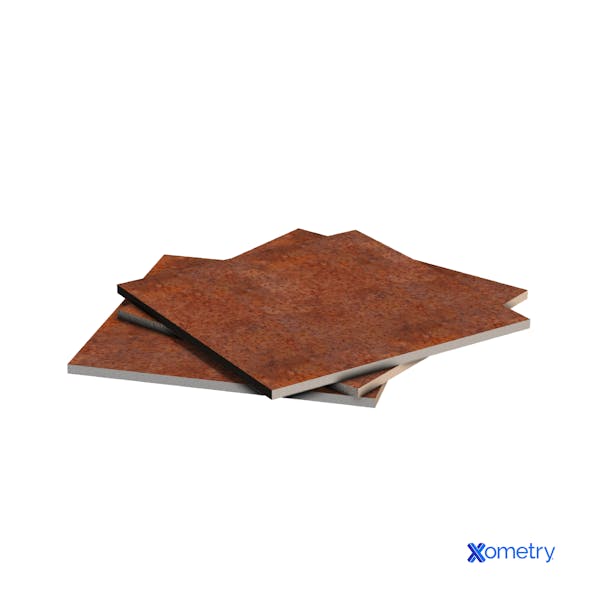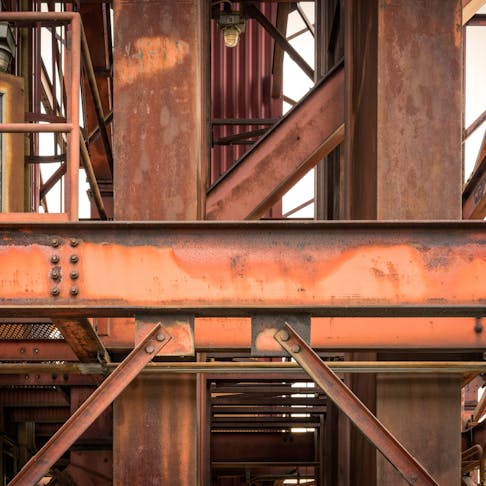Weathering steel is a clever metal that doesn’t need protecting—it’s got the job covered all by itself! Also known as COR-TEN® steel—a United States Steel Corporation (USSC) trademark—this material naturally creates its own armor, as it were. We’ll tell you exactly how it does this, how it’s made, and what it’s used for in this article.
What is Weathering Steel?
Weathering steel is a type of high-strength, low-alloy (HSLA) steel that is chemically formulated to develop a protective rust-like oxide layer called a “patina” on its surface. This patina, which gives the metal its characteristic rustic aesthetic, seals off the metal’s surface from the atmosphere and keeps it protected without the need for extra treatment or coating. The patina extends the metal’s life span and reduces the need for frequent maintenance and painting—which is why weathering steel is commonly used in outdoor settings or situations where conventional steel would very likely rust. Although the patina is technically rust, the rust stays on the surface keeping the metal underneath protected and shielded from further corrosion.
The oxide layer forms thanks to the addition of various alloying elements. Weathering steels have a carbon content below 0.2 wt%, and various alloying elements, like chromium, manganese, phosphorus, copper, and sulfur (the exact compositions can be found in a table a little further down). Together, all elements make up a total content ranging from 1.00 wt% to 5.00 wt%. The extra materials can provide many other perks, too, like more strength and 4–8 times better corrosion resistance than plain, low-carbon steels. For instance, adding copper helps the patina adhere to the metal better and slow corrosion down.
A Brief History
Weathering steel was invented by USSC in the 1930s to fortify ore-carrying hopper carts that transferred iron ore and coal to the furnace. Thanks to its incredible strength, durability, hardness, and corrosion resistance—all without having to apply a coating—weathering steel later found a great deal of uses across many different industries. In the 1950s, it even made its way into architecture, and in 1964, the John Deere Headquarters in Moline, Illinois, was the first building to be clad in weathering steel. Used in this way, the steel gives buildings an aged and grounded ambiance, especially when the patina develops and matures. The trademarked name, which is sometimes written simply as “corten steel,” is a mixture of corrosion resistance (“COR”) and tensile strength (“TEN”).
How it’s Made
Weathering steel is made via a controlled process involving exposure to natural weathering conditions that allows it to develop the aforementioned protective surface layer over time. During the process, the steel surface is first roughened through sanding or blasting. Over time, it’s wetted and dried repeatedly to encourage the patina to develop. There are some methods used to accelerate the process involving chemical treatments or industrial-grade hydrogen peroxide that are sometimes performed. When it’s ready, the surface finish can range from orange-brown to a deeper reddish-brown. The most common form it comes in is sheet or plate steel, which is often used for architectural purposes.
Weathering Steel—At A Glance
Advantages
- Exceptional resistance to atmospheric corrosion
- Excellent tensile strength and durability
- Longer life expectancy than bare, cold-rolled steel (can last several decades to over a century!)
- Protective patina acts as a natural barrier against further corrosion
- Low maintenance needs (i.e., no painting or coating is needed)
- Self-protecting nature helps save costs and lowers environmental impact
- Keeps its strength and structural integrity in challenging environments
- Unique appearance adds artistic and architectural appeal
- Can be welded with appropriate methods (gas shield, spot, or submerged arc welding techniques, depending on steel thickness)
Disadvantages
- Higher initial cost than traditional carbon steel
- The initial rust runoff can stain surrounding areas
- The early rusting stages can result in a less aesthetically pleasing appearance
- Careful consideration is needed during the design phase to prevent water accumulation in crevices
- Not good in high-chlorine environments and some other climate conditions; could lead to issues with the material’s corrosive resistance and durability
Applications
- Architectural structures (i.e., bridges, building facades, etc.)
- Outdoor sculptures/artworks
- Shipping containers
- Railway wagons
- Transmission poles

| Factor | Corten A | Corten B |
|---|---|---|
Factor Carbon (c) Content | Corten A ≤ 0.12 | Corten B ≤ 0.16 |
Factor Manganese (Mn) Content | Corten A 0.20–0.50 | Corten B 0.80–1.25 |
Factor Phosphorus (P) Content | Corten A 0.07–0.15 | Corten B ≤ 0.04 |
Factor Sulfur (S) Content | Corten A ≤ 0.03 | Corten B ≤ 0.03 |
Factor Silicon (Si) Content | Corten A 0.25–0.75 | Corten B 0.30–0.65 |
Factor Chromium (Cr) content | Corten A 0.50–1.25 | Corten B 0.40–0.70 |
Factor Nickel (Ni) Content | Corten A ≤ 0.65 | Corten B ≤ 0.40 |
Factor Copper (Cu) Content | Corten A 0.25–0.55 | Corten B 0.30–0.40 |
Factor Vanadium (V) Content | Corten A n/a | Corten B ≤ 0.10 |
Factor Min. Yield Strength | Corten A 50 ksi (345 MPa) | Corten B 50 ksi (345 MPa) |
Factor Min. Tensile Strength | Corten A 70 ksi (485 MPa) | Corten B 70 ksi (485 MPa) |
Factor Elongation | Corten A 20% (thickness ≤ 12 mm) | Corten B 18% (thickness ≤ 12 mm) |
Factor Comparative Cost | Corten A Moderate* | Corten B Moderate* |
Factor ASTM Standard | Corten A A242 covers steels with the same properties as Corten A | Corten B A588 covers steels with the same properties as Corten B |
Factor Standout Feature | Corten A Improved atmospheric corrosion resistance | Corten B Superior corrosion resistance |
Factor Common Applications | Corten A Bridges, buildings, transportation vehicles | Corten B Bridges, buildings, and welded structures |
Weathering Steel Properties and Composition *Cost varies depending on several factors, including but not limited to quantity, thickness, dimensions, supplier or manufacturer, and location.
ASTM Specifications
Weathering steels are used in corrosion-resistant and high-strength applications, and all of them have minimal yield and tensile strengths of 50 ksi and 70 ksi respectively—other than A871-65, which has 65 ksi and 80 ksi. The below table lists the different ASTM (American Society for Testing and Materials) standards for weathering steel, along with their properties and what they’re used for.
| Specification | Description | Common Applications |
|---|---|---|
Specification A847 | Description Better resistance to atmospheric corrosion than carbon steel | Common Applications Cold-formed welded rectangular and square pipe and tubing, bridges, structures |
Specification A709-50W | Description Structural bars, plates, and shapes with better atmospheric corrosion resistance than carbon steel (regardless of copper presence), requires an atmospheric corrosion index of 6.00 | Common Applications Pedestrian bridges, highway bridge girders, railroad bridges, and overpasses; can be used unpainted in properly designed structures |
Specification A871-65 | Description Steel plate with improved resistance to atmospheric corrosion resistance over carbon steel | Common Applications Power transmission and lighting poles, structural applications |
Specification A242 | Description Designed for steel plates up to ½ inch thick. Provides better corrosion resistance than carbon steels | Common Applications Bridges, building facades, and other exposed structural applications |
Specification A606-4 | Description Available in hot- and cold-rolled sheets, strips, and coils, improved atmospheric corrosion properties | Common Applications Roofing, siding, and other construction and structural elements that can be unpainted when properly designed |
Specification A588 | Description Structural shapes, like angles, channels, beams, plates, and bars, with enhanced atmospheric corrosion resistance, superior durability and weight reduction | Common Applications Welded bridges and structures needing corrosion resistance, weight reduction, and durability |
ASTM Specifications for Weathering Steel
FAQs on Weathering Steel
How does weathering steel differ from regular steel?
The difference between weathering steel and regular steel is that the former has extra alloying elements that allow it to develop a rust-like patina. Regular steel mainly consists of iron and carbon, which is strong but highly susceptible to rust if not protected with some type of coating. Weathering steel is better for outdoor environments but isn’t necessary for indoor or low-corrosion settings, where regular steel would suffice and also prove more cost-effective.
Can weathering steel be tempered?
No, but it doesn’t need to be tempered. Tempering is a heat-treatment process that involves reheating steel to a specific temperature and then cooling it down to achieve desired mechanical properties, such as hardness and toughness. Weathering steel gets these properties as a gradual chemical reaction with the environment over time and doesn’t need a heat treatment.
How Xometry Can Help
You can get a free quote for a variety of different services that we offer here at Xometry, including options specific to weathering steel, like laser cutting, welding, and CNC machining. Get started right away by uploading your designs to the Xometry Instant Quoting Engine®!
Copyright and Trademark Notices
- COR-TEN® is a trademark of United States Steel Corporation (USS)
Disclaimer
The content appearing on this webpage is for informational purposes only. Xometry makes no representation or warranty of any kind, be it expressed or implied, as to the accuracy, completeness, or validity of the information. Any performance parameters, geometric tolerances, specific design features, quality and types of materials, or processes should not be inferred to represent what will be delivered by third-party suppliers or manufacturers through Xometry’s network. Buyers seeking quotes for parts are responsible for defining the specific requirements for those parts. Please refer to our terms and conditions for more information.


